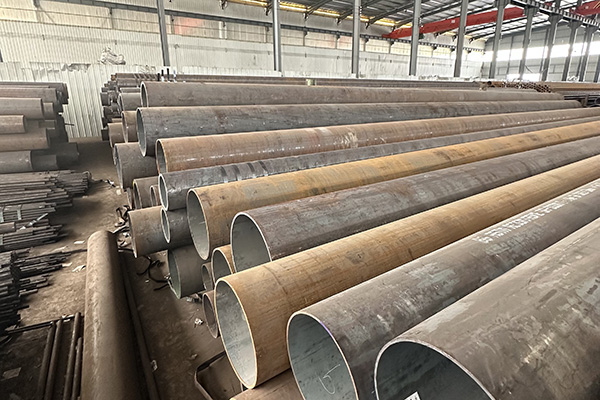
The Role of Alloy Line Pipe in Modern Industry
In the world of high-pressure and large-scale fluid transportation, alloy line pipe stands out as a critical component. Whether moving crude oil, natural gas, steam, or process water, these pipes must deliver consistent reliability under tough operating conditions. Among the available specifications, API 5L X46N is widely recognized for balancing mechanical performance and durability.
Choosing the right line pipe material is not just about compliance—it’s about securing long-term performance and safety for demanding applications.

Why Alloy Line Pipe Delivers Superior Strength
Strength is one of the most valued attributes of alloy line pipe. Compared with standard carbon steel, alloy pipes incorporate elements that enhance performance and structural stability.
·Yield strength advantage: With API 5L X46N, the minimum yield strength reaches about 317 MPa (46,000 psi), ensuring stability under heavy loads.
·Service life extension: Alloyed compositions resist wear and slow degradation, allowing pipelines to operate longer without replacement.
·Crack resistance: The inclusion of specific alloying elements helps reduce vulnerability to fatigue, stress corrosion, and hydrogen-induced cracking.
For industries where failure is not an option, these qualities make alloy line pipe indispensable.
API 5L X46N: Standards that Shape Performance
The API 5L standard defines the global framework for alloy line pipe design. Within this system, X46N is a grade particularly suited for tough conditions.
Key aspects include:
1.Mechanical performance – designed to balance tensile and yield strength.
2.Chemical requirements – strict alloying and composition rules that ensure resilience against corrosion and extreme environments.
3.PSL1 vs. PSL2 grades – API 5L differentiates line pipe quality, with PSL2 involving tighter chemical limits, toughness requirements, and testing protocols.
Compliance with API 5L ensures the pipeline is not only technically sound but also accepted across multiple industries and geographies.
Core Applications of Alloy Line Pipe
Alloy line pipe’s versatility is proven by its broad industrial use. Major applications include:
·Energy sector transport – conveying natural gas, crude oil, and refined products safely over long distances.
·High-temperature systems – carrying steam or hot water under constant pressure.
·Infrastructure and structural uses – providing mechanical stability in construction and heavy-duty installations.
·Petrochemical industries – supporting operations where corrosion resistance is critical.
API 5L X46N is often preferred in these cases because it offers an optimal balance between toughness and resistance.
How to Select the Right Alloy Line Pipe
Making the right selection requires analyzing both technical and operational needs. Considerations include:
1.Service environment – pressure, operating temperatures, and exposure to chemicals.
2.Pipe grade – alignment with API 5L requirements, with X46N offering reliable mid-range performance.
3.Sizing – pipe diameter and wall thickness must meet flow and load demands.
4.Longevity and maintenance – durable alloy compositions reduce replacement cycles and cut lifecycle costs.
Thoughtful selection early in the project minimizes risks and enhances operational efficiency.
Alloy Line Pipe and Future Demands
The pipeline industry continues to evolve. Demand for safer, stronger, and more sustainable solutions is driving improvements in alloy metallurgy and heat treatment technologies. These advances enhance fatigue resistance, corrosion tolerance, and overall lifespan.
At the same time, the API 5L standard adapts to these innovations, ensuring that materials like X46N alloy line pipe remain relevant for modern infrastructure challenges.
Conclusion: Alloy Line Pipe as the Industry Backbone
From high tensile strength and compliance with API 5L to proven resistance in harsh environments, alloy line pipe has become the foundation of industrial fluid transport systems. The X46N grade offers an ideal mix of toughness, durability, and long-term stability.
Whether applied in oil and gas, steam distribution, or petrochemical facilities, the choice of alloy line pipe directly impacts operational safety and efficiency. At every stage of design and installation, one factor remains clear: alloy line pipe is essential for building reliable, high-performance pipelines.
References
GB/T 7714:Venegas V, Caleyo F, González J L, et al. EBSD study of hydrogen-induced cracking in API-5 L-X46 pipeline steel[J]. Scripta materialia, 2005, 52(2): 147-152.
MLA:Venegas, V., et al. "EBSD study of hydrogen-induced cracking in API-5 L-X46 pipeline steel." Scripta materialia 52.2 (2005): 147-152.
APA:Venegas, V., Caleyo, F., González, J. L., Baudin, T., Hallen, J. M., & Penelle, R. (2005). EBSD study of hydrogen-induced cracking in API-5 L-X46 pipeline steel. Scripta materialia, 52(2), 147-152.





